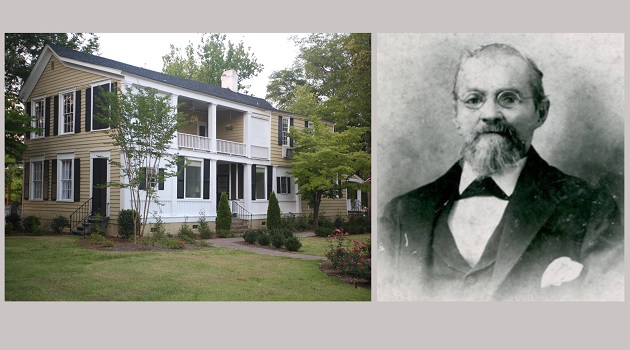The story of Camden’s Joshua Reynolds House and its colorful tenant Dr. George Rogers Clark Todd, brother-in-law of Pres. Abraham Lincoln
By W. Thomas Smith Jr.
HISTORY IS ALL AROUND US, reminding me also of what a small world we live in, what a brief span of national history our own United States exists within, and how everything and everyone is in some way connected: Which brings me to an old antebellum house in which I’ve attended lectures and receptions, had my picture taken in front of, eaten my lunch on the steps of, and parked my car next to and walked past at least once a month – usually two or three times a month – for more than 10 years.
I’m talking about the historic Joshua Reynolds House in Camden, South Carolina, the oldest inland town in the Palmetto State.
Part of the Mullikin Law Firm complex a mile or two on the main drag from Lord Charles Cornwallis’ headquarters during the American Revolution to the site of the Battle of Camden several miles away, the Joshua Reynolds House was built in 1805 (some sources say circa 1816) and it was placed on the National Register of Historic Places in 1971. And, no, Camden’s Joshua Reynolds is not the same man as the famous artist Sir Joshua Reynolds, 1723-1792.
Today the Reynolds House (aka the Reynolds-Todd-Mullikin House) at 1310 Broad serves as the environmental training facility for GLOBAL ECO ADVENTURES (GEA), founded by Dr. Tom Mullikin, who is the “Mullikin” in the Mullikin Law Firm, located directly across the shared driveway at 1308 Broad, also a historically significant structure which we’ll save for another story.
According to GEA’s website, the 1310 building was constructed by Reynolds “as the ‘Long Town Store’ for Samuel Mathis,” and according to a nearby S.C. historical marker, Mathis, 1760-1823, was “the first white male child born in Camden and enjoyed a long career as a soldier, merchant, lawyer, politician, and preacher.”
Though few outside of Camden circles know, the Reynolds House, which I’ve always referred to as the Todd House, also served as the medical offices of Dr. George Rogers Clark Todd, brother-in-law of the 16th president of the United States Abraham Lincoln.
Yes, Dr. Todd was First Lady Mary Todd Lincoln’s brother. But to Mrs. Lincoln’s great consternation, Dr. Todd served in the very army that her husband was trying to destroy from 1861 to 1865. But then so did three of her other brothers: Alexander (killed at Baton Rouge), Samuel (killed at Shiloh), and David Todd (wounded at Vicksburg).
Born in Lexington, Kentucky on July 2, 1825; Dr. George R.C. Todd sided with the Confederacy when South Carolina seceded from the Union on Dec. 20, 1860. When war erupted the following Spring, he offered his services as a surgeon to the Confederate Army. For a time he served at one of the hospitals in Charleston where he was tasked with caring for prisoners of war in a nearby POW camp. He was also with Gen. Robert E. Lee’s Army of Northern Virginia during the ill-fated Gettysburg campaign in 1863.
A somewhat gruff, irascible soul, Dr. Todd was NOT known for his comforting bedside manner, though the unreconstructed surgeon was known for his harsh outspoken criticism of his brother-in-law Pres. Lincoln, whom he once referred to as “one of the greatest scoundrels unhung.”
When the war ended in 1865, Dr. Todd relocated to Camden, the home of his wife Martha B. “Mattie” Lyles Todd. There he set up his medical practice in the Reynolds House on Broad.
In 1880, the Todd couple along with their 11-year-old son George Belton Todd packed up and moved from Camden to Barnwell County. They eventually returned to Camden where Martha passed away in 1889, though some sources suggest they remained in Barnwell until the end of their lives. What we do know for a fact is that Dr. Todd passed away on April 28, 1900, and both he and Martha are buried in Camden’s historic Quaker Cemetery (where Mullikin’s parents are both interred along with several notable general-officers, a governor, a lieutenant governor, and two Medal of Honor recipients), one-and-a-half miles south of what was once Dr. Todd’s office, today GEA’s Environmental Training Center.
Not only GEA training, but the Reynolds-Todd-Mullikin House today includes Mullikin’s military mini-museum featuring unusual pieces of military history from the earliest Provincial Militia in 1670 (Mullikin previously served as the two-star commanding general of the Provincial Militia’s descendent organization, the S.C. State Guard) to the 21st-century War on Terror (Mullikin served as an officer in the post-9/11 U.S. Army Reserve and he has long been a deeply involved supporter of the U.S. special operations community). The building also houses a “Reconciliation Room” dedicated to the Civil Rights movement in South Carolina (Mullikin has also hosted “Reconciliation Rides” across the Palmetto State), and the house was once home to the Mullikin Karate Studio (Mullikin is a member of the S.C. Black Belt Hall of Fame).
“It’s fascinating to me and to all who visit our building to think that Mary Todd Lincoln’s brother practiced medicine right here,” said Mullikin. “It’s a unique piece of history that fits right in with the mystique and multi-layered, interconnected story of Camden.”
By the way, George, Alexander, Samuel, and David Todd weren’t the only Confederates in Mary Todd Lincoln’s woodpile. The first lady’s brother-in-law (married to her sister Emilie) was Brig. Gen. Benjamin Hardin Helm, CSA.
Abraham Lincoln had offered Helm a commission in the U.S. Army. Helm instead accepted a commission in the Confederate Army and was killed during the bloody Battle of Chickamauga in 1863.
Yep, everything is connected, and no history is richer than that of old Camden.
– Pictured is the Joshua Reynolds House and Dr. George Rogers Clark Todd.


